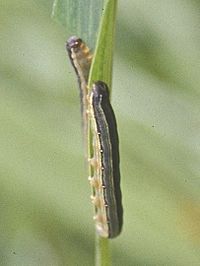
Photo from wikipedia
BACKGROUND Mythimna separata is a notorious pest causing crop damages at the larval stage. Gaining insight into larval olfaction mechanisms would provide knowledge for olfaction-based management of M. separata larvae.… Click to show full abstract
BACKGROUND Mythimna separata is a notorious pest causing crop damages at the larval stage. Gaining insight into larval olfaction mechanisms would provide knowledge for olfaction-based management of M. separata larvae. RESULTS In the present research, (Z)-11-hexadecenal (Z11-16: Ald), a major component of M. separata sex pheromone, was found to attract early-instar larvae of M. separata in a food context. Using a fluorescent binding assay, we found that M. separata general odorant binding protein 2 (MsepGOBP2) exhibited high binding affinity to Z11-16: Ald. Further, silencing of MsepGOBP2 resulted in a sharp reduction of the response to Z11-16: Ald, which could not be mitigated by increasing the concentration of Z11-16: Ald. Additionally, we employed molecular dynamics-based approaches to unravel the interaction details between MsepGOBP2 and Z11-16: Ald, specifically the binding of Z11-16: Ald to MsepGOBP2. CONCLUSION Z11-16: Ald is attractive to early-instar larvae of M. separata, and MsepGOBP2 is identified to be indispensable in the larval detection of Z11-16: Ald. These results could aid in the development of olfaction-based methods for controlling M. separata in the larval stage. This article is protected by copyright. All rights reserved.
Journal Title: Pest management science
Year Published: 2023
Link to full text (if available)
Share on Social Media: Sign Up to like & get
recommendations!